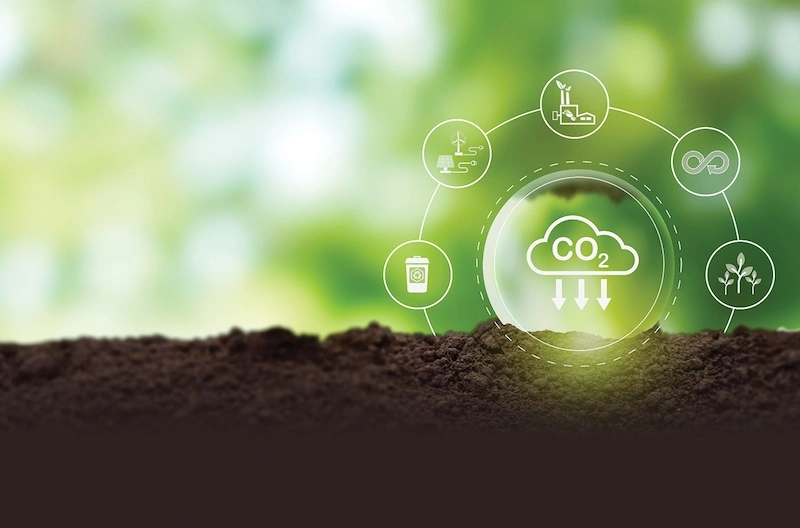Sources of greenhouse gas emissions
Sources of greenhouse gas emissions
20 March 2024
The primary sources of greenhouse gas emissions come from where?
The increasing greenhouse effect has become a growing concern, causing the Earth to warm up. According to the IPCC report, the concentration of greenhouse gases such as CO2, CH4, N2O has significantly increased since the industrial revolution. So what are the main sources of greenhouse gas emissions today? Let's explore the answer with Minmax Green through the following article.
Greenhouse gas emissions sources (Image source: Collected)
The impact of greenhouse gas emissions on the environment
Greenhouse gas emissions increase the concentration of gases such as CO2, CH4, N2O in the atmosphere. These greenhouse gases begin to absorb infrared radiation from the Earth's surface and trap heat, causing the Earth to warm up every day, leading to global climate change. The consequences of climate change and global warming due to the greenhouse effect have resulted in many negative impacts:
-
• Melting polar ice, rising sea levels due to melting ice, causing flooding and erosion in coastal areas.
• Changing the amount and frequency of rainfall, increasing extreme weather phenomena such as storms, floods, and droughts.
• Impacting human health due to air pollution and outbreaks of diseases.
• Global warming leading to a decline in biodiversity, ecological imbalance, putting many species of animals and plants at risk of extinction.
• Reducing agricultural productivity due to extreme weather and loss of seasons.
Therefore, greenhouse gas emissions have a significant impact on the natural environment and human health. So why are greenhouse gas emissions increasing? Where do the main sources of greenhouse gas emissions come from?
The environment is severely affected by greenhouse gas emissions. (Image source: Collected)
So why are greenhouse gas emissions increasing? Where do the main sources of greenhouse gas emissions come from?
Synthesis of the main sources of greenhouse gas emissions nowadays
Based on the sources, emission levels, and emission trends influencing the total potential greenhouse gas emissions of countries, we can categorize the sources of greenhouse gas emissions into 4 main groups as follows:
Greenhouse gas emissions from the energy sector are among the largest sources of greenhouse gas emissions currently. They account for up to 90% of CO2 and 75% of other greenhouse gases in developing countries.(1)
Emissions in the energy sector are divided into 3 main groups:
• Emissions from the combustion of fossil fuels - originating from the energy industry, transportation activities, etc.
• Instantaneous emissions - due to the leakage of gas and vapor from compressed equipment, or originating from the fuel extraction, transportation, and processing processes.
• Emissions from carbon capture and storage activities.
Burning fossil fuels is also one of the sources of greenhouse gas emissions. (Image source: Collected)
Of the 3 groups, greenhouse gas emissions from the combustion of fossil fuels contribute to 70% of the total emissions, especially from oil refineries and power plants.
Emissions from the Industrial Processes and Product Use (IPPU)
The processing of industrial and product use (IPPU) is also one of the significant sources of greenhouse gas emissions. The primary source of emissions is the industrial processes involving chemical or physical processing of raw materials to produce goods, rather than energy production.
Industrial processes can emit greenhouse gases. (Image source: Collected)
Throughout this process, various greenhouse gases such as CO2, CH4, N2O, HFCs, and PFCs are generated. These gases contribute about 6 - 7% of the total emissions worldwide.
Emissions from Agriculture, Forestry, and Other Land Use (AFOLU)
When considering the common sources of greenhouse gas emissions today, we cannot overlook the emissions from agricultural activities, livestock breeding, and rice cultivation. These activities are significant sources of CH4 and N2O emissions into the environment.
Rice cultivation in agriculture also contributes to greenhouse gas emissions. (Image source: Collected)
Furthermore, changes in land use and forestry exploitation, reduction in forest and green area, severely impact the absorption of CO2. Currently, emissions from AFOLU account for up to 30% of the total global greenhouse gas emissions.
Greenhouse Gas Emissions from Waste
Waste has also become a significant source of greenhouse gas emissions such as CO2, CH4, and N2O. These gases can be generated from the process of solid waste burial, wastewater treatment and discharge, biological treatment of solid waste, waste incineration, and more. Specifically, a significant amount of CH4 is generated from landfill sites and constitutes a large proportion of the total greenhouse gas emissions in this sector. Additionally, the process of waste discharge and treatment releases NOx, NH3, and CO. NOx and NH3 can indirectly create N2O - an essential component of greenhouse gases.
Waste is also a significant source of greenhouse gas emissions (Image source: Collected)
How is the current situation of greenhouse gas emissions in Vietnam?
Currently, Vietnam has committed to reducing its greenhouse gas emissions by 8% in 2023 compared to 2010 through domestic resources within the framework of the United Nations Framework Convention on Climate Change. This reduction target could increase to 25% with international community assistance. In order to fulfill this commitment, Vietnam has implemented various activities to reduce greenhouse gas emissions. The nation has begun to establish guidelines for managing and inventorying greenhouse gas emissions, which are being implemented nationwide. According to the new regulations, facilities or enterprises with annual emissions of 3,000 tons of CO2 or more, or falling under certain specified categories, are required to conduct greenhouse gas emissions inventory.
Image source: tapchicongthuong.vn (2)
Documenting References
Currently, Vietnam has committed to reducing its greenhouse gas emissions by 8% in 2023 compared to 2010 through domestic resources within the framework of the United Nations Framework Convention on Climate Change. This reduction target could increase to 25% with international community assistance. In order to fulfill this commitment, Vietnam has implemented various activities to reduce greenhouse gas emissions. The nation has begun to establish guidelines for managing and inventorying greenhouse gas emissions, which are being implemented nationwide. According to the new regulations, facilities or enterprises with annual emissions of 3,000 tons of CO2 or more, or falling under certain specified categories, are required to conduct greenhouse gas emissions inventory.
Why do businesses need to conduct greenhouse gas inventory in 2024?
There are several main reasons why businesses need to report their greenhouse gas inventory this year:
• To monitor and understand the amount of greenhouse gases emitted by businesses each year, and take appropriate measures to minimize greenhouse gas emissions.
• Proactive inventory of greenhouse gases demonstrates responsibility to society and the environment concerning climate change issues.
• Compliance with legal requirements and regulations of the State related to environmental protection.
• Enhancing the reputation and credibility of businesses with the community and international organizations. Reporting greenhouse gas inventory demonstrates environmental protection awareness by the business.
• Opportunities to receive funding and benefits in terms of credit, tax advantages from green financial institutions for businesses.
Greenhouse gas inventory must be carried out by professional consulting firms familiar with the regulations and procedures in accordance with the law. If your business needs consulting on greenhouse gas inventory reporting, please contact Minmax Green using the information below for the fastest support.
Conclusion
Hopefully, through this article, you have gained a better understanding of the main sources of greenhouse gas emissions that cause the greenhouse effect and global climate change. Let's work together to protect the environment with practical actions every day.
—-------------------
Sources referenced:
(1) Emission sources and directions for reducing greenhouse gas emissions.
https://tapchimoitruong.vn/phap-luat--chinh-sach-16/C%C3%A1c-ngu%E1%BB%93n-ph%C3%A1t-th%E1%BA%A3i-v%C3%A0-%C4%91%E1%BB%8Bnh-h%C6%B0%E1%BB%9Bng-gi%E1%BA%A3m-ph%C3%A1t-th%E1%BA%A3i-kh%C3%AD-nh%C3%A0-k%C3%ADnh-19268
(2) Analysis of greenhouse gas emissions in Vietnam. https://tapchicongthuong.vn/bai-viet/phan-tich-thuc-trang-phat-thai-khi-nha-kinh-tai-viet-nam-72541.htm
Let’s contact us
+84 931 861 313
68 Nguyen Hue, Ben Nghe Ward, District 1, Ho Chi Minh City, Vietnam
team@minmaxgreen.vn




